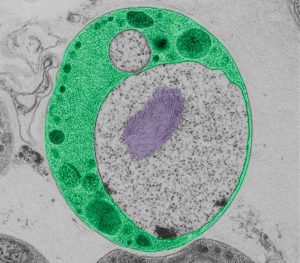
Wrapped in purple
Science & Technology The medaka shown in this Picture of the Week was captured by Eva Hasel, a postdoc in the Leptin group at EMBL Heidelberg.
2020
picture-of-the-weekscience-technology

Science & Technology The medaka shown in this Picture of the Week was captured by Eva Hasel, a postdoc in the Leptin group at EMBL Heidelberg.
2020
picture-of-the-weekscience-technology

Science & Technology Despite missing the characteristic stripes one would expect from a zebra – or a zebrafish – the fractals in this Picture of the Week show a zebrafish; or at least some cells in a zebrafish embryo, a few hours after fertilisation. Zebrafish are not only popular aquarium fish, they are also an…
2019
picture-of-the-weekscience-technology

Science & Technology Model organisms are species that are studied extensively to understand particular biological phenomena and processes, with the expectation that discoveries made in the model organism will provide insight into the workings of other organisms. The small marine ringed worm Platynereis dumerilii gained…
2019
picture-of-the-weekscience-technology

Science & Technology EMBL researchers discover that four organs in a marine worm’s head can sense different chemicals
2018
sciencescience-technology

People & Perspectives New group leader at EMBL Barcelona creates artificial biological systems to study animal development
2018
people-perspectivesscience
Science & Technology Of mice and gorillas: using mouse data for conservation
2018
sciencescience-technology
Science & Technology Launch of the first free global online catalogue of PDX models
2018
sciencescience-technology

Lab MattersPeople & Perspectives Curious about what goes on in EMBL’s Fly Room? Prepare to be a fly on the wall
2017
lab-matterspeople-perspectives

People & Perspectives EMBL alumna Sigrid Reinsch trained as a cell biologist – now she helps run experiments in space
2017
alumnipeople-perspectives

Science & Technology A summary of recent research highlights from EMBL
2017
sciencescience-technology

Science & Technology Five things researchers have learned from bizarre fruit flies
2017
sciencescience-technology

Science & Technology EMBL researchers complete a molecular atlas showing gene expression in all cells in an entire animal
2017
sciencescience-technology

Science & Technology ERC grantee Detlev Arendt shares his vision for the next ten years
2017
sciencescience-technology

Lab MattersPeople & Perspectives Ewan Birney on the risks, rewards and realities of studying humans as a model species.
2015
lab-matterspeople-perspectives

Lab Matters Halldór Stefánsson on the long history of complex interactions between humans and animals.
2015
lab-matters

ConnectionsLab Matters Maria Kamber, who heads the mouse facility, ensures “dignity, compassion and respect” for her charges.
2015
connectionslab-matters

Science & Technology New single-cell genomics techniques bring ‘omics to evolution and development research.
2015
sciencescience-technology

Science & Technology Although they are present almost everywhere, on land and sea, a group of related bacteria in the superphylum Planctomycetes-Verrucomicrobia-Chlamydiae, or PVC, have remained in relative obscurity ever since they were first described about a decade ago. Scientists at the European Molecular Biology…
2010
sciencescience-technology

Science & Technology The life of a cell is all about growing and dividing at the right time. That is why the cell cycle is one of the most tightly regulated cellular processes. A control system with several layers adjusts when key components of the cell cycle machinery are produced, activated and degraded to make sure…
2006
sciencescience-technology
ConnectionsLab Matters Today three research organisations announce the merging of their expertise to fight cardiovascular diseases, which are among the most common health problems and causes of death in the world. The Magdi Yacoub Institute (MYI) at the UK’s Harefield Heart Science Centre, Imperial College London,…
2006
connectionslab-matters
Science & Technology Scientists at the European Molecular Biology Laboratory (EMBL) in Heidelberg and the Institute of Biomedical Research of the Parc Científic de Barcelona (IRB-PCB) have now added key evidence to claims that some types of cancer originate with defects in stem cells. The study, reported this week in…
2005
sciencescience-technology
No matching posts found
Looking for past print editions of EMBLetc.? Browse our archive, going back 20 years.
EMBLetc. archive